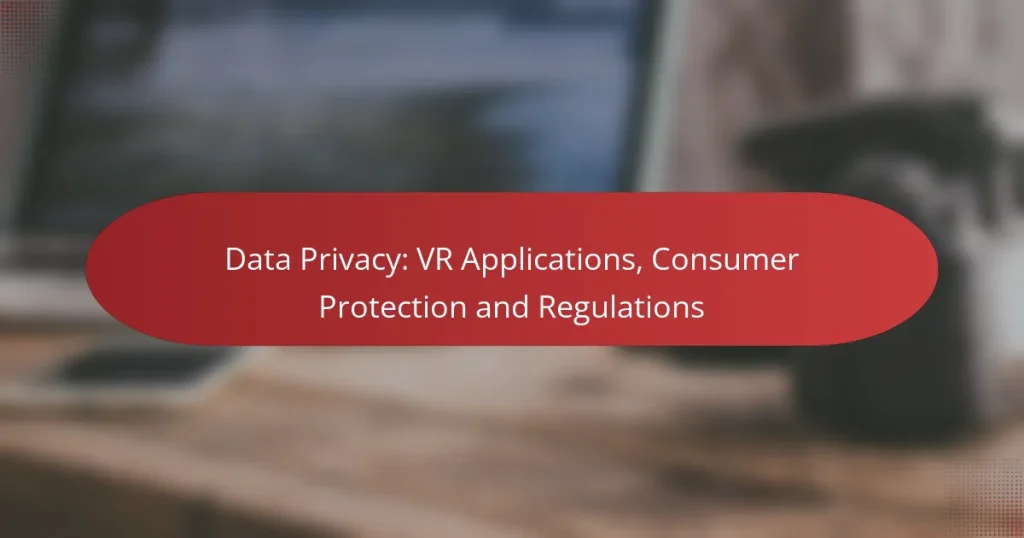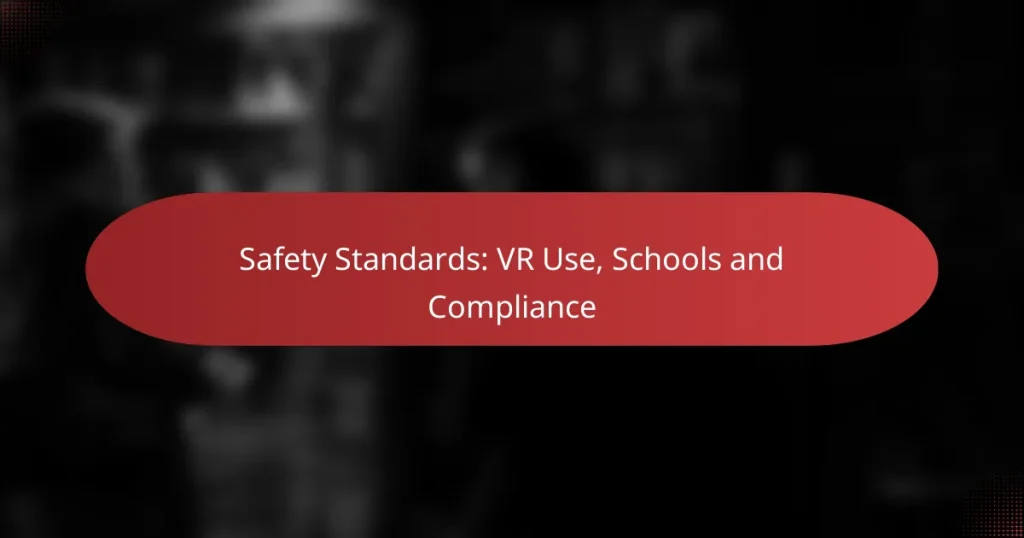Safety and compliance in virtual reality (VR) are critical to ensuring a positive user experience while minimizing risks. In the UK, adherence to standards such as ISO 9241-210 and guidelines from the British Standards Institution is essential for protecting users from physical injuries, psychological effects, and data privacy issues. By implementing structured processes and regular assessments, businesses can enhance safety and ensure compliance in their VR offerings.
Safety Standards: VR Use, Schools and Compliance
Compliance in VR: Content Creation, Business Standards and Regulations
What are the safety standards for virtual reality in the UK?
In the UK, safety standards for virtual reality (VR) focus on ensuring user safety, comfort, and overall experience quality. Key standards include ISO 9241-210 compliance, guidelines from the British Standards Institution (BSI), and regulations set by the Health and Safety Executive (HSE).
ISO 9241-210 compliance
ISO 9241-210 is an international standard that emphasizes user-centered design principles for interactive systems, including virtual reality. Compliance involves ensuring that VR systems are designed with the user’s needs and experiences in mind, promoting usability and accessibility.
To achieve compliance, developers should conduct user testing to gather feedback and make iterative improvements. This may include evaluating the ease of navigation, comfort during use, and the overall immersive experience.
British Standards Institution (BSI) guidelines
The BSI provides guidelines that help organizations implement best practices for VR technology. These guidelines cover aspects such as risk assessment, user training, and equipment maintenance to ensure a safe VR environment.
Organizations should regularly review these guidelines to stay updated on safety practices. This includes conducting regular training sessions for users and staff to minimize risks associated with VR usage.
Health and Safety Executive (HSE) regulations
The HSE outlines regulations that govern workplace safety, which also apply to VR environments. Employers must assess risks associated with VR use, including physical hazards and potential psychological effects on users.
To comply with HSE regulations, organizations should implement safety measures such as clear usage guidelines, regular equipment checks, and ensuring that users take breaks to reduce fatigue and discomfort during VR sessions.
How can businesses ensure compliance in virtual reality?
Businesses can ensure compliance in virtual reality by implementing structured processes that address safety and regulatory standards. This involves conducting regular assessments, providing adequate training, and establishing channels for user feedback to continuously improve the VR experience.
Regular risk assessments
Conducting regular risk assessments is crucial for identifying potential hazards in virtual reality environments. These assessments should evaluate both the technology and the user experience, focusing on aspects such as physical safety, data privacy, and compliance with industry regulations.
Businesses should schedule these assessments at least annually or whenever significant changes are made to the VR system. Utilizing checklists can help ensure all critical areas are reviewed, including equipment safety, user interface design, and accessibility features.
Employee training programs
Implementing comprehensive employee training programs is essential for ensuring that staff understand the safety protocols and compliance requirements associated with virtual reality. Training should cover the proper use of VR equipment, emergency procedures, and data protection practices.
Consider using a mix of training methods, such as hands-on workshops and online courses, to accommodate different learning styles. Regularly updating training materials to reflect new technologies and regulations will help maintain compliance and enhance user safety.
Implementing user feedback mechanisms
Establishing user feedback mechanisms allows businesses to gather insights directly from VR users, which can highlight compliance issues or safety concerns. Feedback can be collected through surveys, focus groups, or direct interviews, providing valuable information for ongoing improvements.
Encouraging users to report their experiences and any difficulties they encounter can lead to timely adjustments in the VR environment. This proactive approach not only enhances user satisfaction but also helps ensure that the VR system remains compliant with safety standards and regulations.
What are the common safety risks in virtual reality?
Common safety risks in virtual reality include physical injuries from equipment, psychological effects of immersion, and data privacy concerns. Understanding these risks is essential for users and developers to create a safer VR experience.
Physical injuries from equipment
Physical injuries in virtual reality often arise from the use of headsets and controllers. Users can experience discomfort, strains, or even falls while navigating virtual environments, especially in confined spaces.
To mitigate these risks, ensure a clear play area free of obstacles and use safety straps on equipment. Regular breaks can also help reduce fatigue and prevent injuries.
Psychological effects of immersion
The immersive nature of virtual reality can lead to various psychological effects, including motion sickness, disorientation, and anxiety. Users may struggle to differentiate between the virtual and real worlds, which can exacerbate these issues.
To minimize psychological risks, limit session lengths to 20-30 minutes and gradually increase exposure. Providing users with clear exit strategies can also help them feel more secure during their experience.
Data privacy concerns
Data privacy is a significant concern in virtual reality, as users often share personal information and biometric data. This data can be vulnerable to breaches or misuse if not properly secured.
To protect privacy, users should review the data policies of VR applications and opt for platforms that prioritize data security. Enabling privacy settings and being cautious about sharing personal information can further enhance safety.
How to choose a compliant virtual reality platform?
Choosing a compliant virtual reality platform involves evaluating vendor certifications, user safety features, and data protection measures. These factors ensure that the platform meets industry standards and provides a safe environment for users.
Evaluate vendor certifications
Start by checking if the vendor holds relevant certifications such as ISO 27001 for information security or GDPR compliance for data protection in Europe. These certifications indicate that the vendor adheres to recognized standards for safety and compliance.
Additionally, look for industry-specific certifications that may apply, depending on your use case, such as those related to healthcare or education. This can help ensure that the platform is suitable for your specific needs.
Check for user safety features
User safety features are crucial in virtual reality platforms to prevent accidents and injuries. Look for options such as adjustable play areas, safety warnings, and user-friendly interfaces that promote safe usage.
Consider platforms that offer features like automatic boundary detection and emergency stop functions. These can significantly reduce the risk of physical harm while users are immersed in the virtual environment.
Assess data protection measures
Data protection is vital in maintaining user trust and compliance with regulations. Ensure the platform employs encryption for data transmission and storage, as well as robust authentication methods to protect user accounts.
Review the vendor’s privacy policy to understand how user data is collected, used, and shared. Look for clear guidelines on data retention and user rights, which can help you gauge the platform’s commitment to data protection.
What are the emerging trends in VR safety and compliance?
Emerging trends in virtual reality (VR) safety and compliance focus on integrating advanced technologies and adapting protocols to ensure user protection. Key developments include the use of artificial intelligence for risk management, the creation of adaptive safety protocols, and the implementation of enhanced privacy regulations.
Integration of AI for risk management
Artificial intelligence is increasingly being utilized in VR to identify and mitigate potential risks. AI systems can analyze user behavior in real-time, detecting anomalies that may indicate unsafe situations or compliance issues. This proactive approach allows developers to address concerns before they escalate.
For instance, AI can monitor user interactions and environmental factors, providing alerts when users are at risk of injury or when the system detects non-compliance with safety standards. Companies should consider investing in AI-driven solutions to enhance their safety measures.
Development of adaptive safety protocols
Adaptive safety protocols are being designed to respond dynamically to the unique needs of VR environments. These protocols adjust based on user experience, environmental conditions, and specific application requirements, ensuring that safety measures are relevant and effective. This flexibility is crucial as VR technology continues to evolve.
For example, a VR training simulation for emergency responders may require different safety protocols than a gaming application. Developers should regularly review and update their safety protocols to align with the latest advancements and user feedback.
Enhanced user privacy regulations
As VR technology collects vast amounts of personal data, enhanced privacy regulations are becoming essential. Compliance with regulations such as the General Data Protection Regulation (GDPR) in Europe is critical for companies operating in this space. These regulations mandate transparency in data usage and require user consent for data collection.
Organizations should implement robust data protection measures and ensure that users are informed about how their data is used. Regular audits and compliance checks can help maintain adherence to privacy standards, fostering user trust and safety in VR applications.


